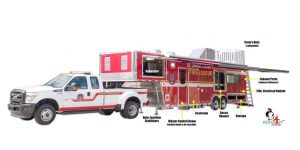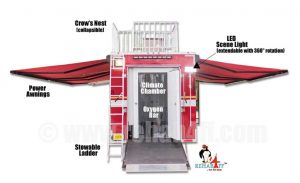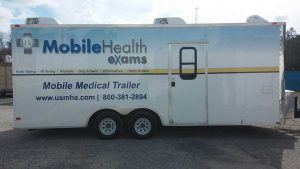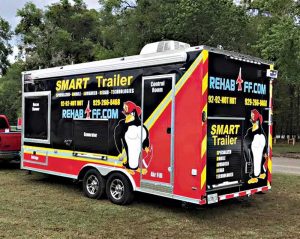There’s a lot to consider before investing in a disaster relief vehicle. At M&R Specialty Trailers and Trucks we’ve been custom building these mobile units for over 20 years. Here’s what you need to know before you buy.
- What are Disaster Relief Vehicles?
- Equipment Options
- Ways to Customize
- Cost of Disaster Relief Vehicles
- What do you need?
What are Disaster Relief Vehicles?
Disaster relief vehicles are special vehicles designed to help people during and after natural disasters like floods, earthquakes, hurricanes, and wildfires. These emergency response vehicles are equipped with tools, supplies, and equipment needed for emergency response efforts.
Disaster relief vehicles can include ambulances for medical aid, mobile kitchens for food distribution, water tankers to supply clean drinking water, and trucks loaded with tents and blankets for shelter. Their main purpose is to reach affected areas quickly, provide immediate assistance to survivors, and support the recovery process by delivering essential services and supplies.

Mobile command center.
What Equipment Can Be Installed?
Here’s a table outlining different types of equipment that could be installed on a disaster relief vehicle, along with their intended purpose or use. Give us a call at 904-397-0246 and let us know your vision and we can help you determine specific equipment and other considerations that are important.
| Equipment Type | Purpose/Use |
|---|---|
| Medical Supplies | To provide on-site medical treatment and emergency care. |
| Communication Equipment | For coordinating rescue operations and maintaining contact with command centers. |
| Water Purification System | To supply clean drinking water in areas where water sources are contaminated. |
| Mobile Kitchen | For preparing and distributing hot meals to victims and responders. |
| Search and Rescue Tools | Includes ropes, cutters, and thermal imaging cameras for rescue operations in collapsed structures. |
| Shelter Supplies | Tents, blankets, and portable heating units for providing immediate shelter. |
| Power Generation Equipment | Generators and solar panels to supply electricity in areas with power outages. |
| Sanitation Facilities | Portable toilets and hand washing stations to maintain hygiene. |
| Navigation and Mapping Tools | GPS devices and drones for surveying disaster zones and planning routes. |
| Heavy-Duty Winches and Tow Equipment | For removing debris, assisting in vehicle recovery, and clearing access paths. |
Ways to Customize?

Custom built for fire department.
Disaster relief vehicles can be highly customized to meet the specific needs of different disaster scenarios and the organizations that operate them. Here are ways a disaster relief vehicle could be customized. Keep in mind there’s nearly a limitless number of options when it comes to customization of these units based on your need.
1. Specialized Equipment Installation
- Medical Equipment: For ambulances or mobile clinics, including advanced life-support systems, patient monitoring devices, and emergency treatment facilities.
- Communication Technologies: Installing state-of-the-art communication tools like satellite phones, GPS tracking, and internet connectivity to ensure constant communication in areas where the usual networks might be down.
- Water Purification Systems: For vehicles focused on providing clean drinking water, integrating advanced water purification systems capable of processing large volumes of water quickly.
2. Storage Solutions
- Custom shelving, racks, and compartments for efficiently organizing supplies such as food, water, medical supplies, and tools.
- External storage solutions like roof racks or external boxes for additional equipment like tents, blankets, or bulky items.
3. Power Supply Modifications
- Adding solar panels or additional battery packs to power onboard equipment independently of the vehicle’s engine, ensuring that critical operations can continue even when the vehicle is stationary.
- Installing an external power outlet system to provide electricity for other relief operations or for affected individuals to charge devices.
What Organizations Use Disaster Relief Vehicles?
Disaster relief vehicles are crucial assets for a wide range of organizations involved in emergency response and humanitarian aid. These organizations often operate in scenarios where quick, efficient, and effective response is critical to saving lives, providing essential services, and facilitating recovery efforts. At M&R Specialty Trailers and Trucks we have years of experience building units for non-profits, fire departments, and police departments.
Here are some key types of organizations that need disaster relief vehicles:
- Government Emergency Management Agencies: National and local government entities responsible for coordinating responses to natural disasters, public health emergencies, and other crises.
- Non-Governmental Organizations (NGOs): These include international and local NGOs focused on humanitarian aid, disaster relief, and development work, such as the Red Cross, Red Crescent, and Doctors Without Borders (Médecins Sans Frontières).
- Fire Departments: Firefighting units often require specialized disaster relief vehicles for rescue operations, medical emergencies, and to manage wildfires.
- Search and Rescue (SAR) Organizations: SAR teams need vehicles equipped with tools and equipment for locating and assisting people in distress or danger in remote or difficult-to-access areas.
- Police Departments and Law Enforcement Agencies: They require disaster relief vehicles for maintaining order, securing areas, and assisting in evacuations and rescue operations.

Provide support anywhere.
These organizations depend on disaster relief vehicles to perform a wide range of functions, from direct rescue and medical assistance to logistical support and infrastructure repair.
How Much Will a Disaster Relief Vehicle Cost?
The cost of disaster relief vehicles can vary widely based on factors like size, customization, equipment installed, and the vehicle’s intended use. Given the broad spectrum of disaster relief vehicles—from basic supply trucks to highly specialized mobile command centers or medical units—the price range is quite expansive.
Mid-Range Vehicles: More specialized vehicles, such as ambulances, mobile kitchens, or medium-sized command centers with moderate equipment levels, can range from $80,000 to $300,000. This price includes the cost of the vehicle itself and the installation of specific equipment.
Highly Specialized Vehicles: For top-of-the-line, fully customized vehicles like advanced mobile command posts, medical units with state-of-the-art equipment, or vehicles designed to operate in extreme conditions, prices can range from $300,000 to over $1 million.
These prices are broad estimates and can vary significantly based on the specific requirements, new versus used status, and the level of technological integration.
What type of disaster vehicle do you need?
When considering the purchase of a disaster relief vehicle, compiling detailed information about your needs, expectations, and the operational requirements of the vehicle is essential. This preparation ensures that the vehicle you select is well-suited for the tasks it will need to perform. Here are key pieces of information and factors to consider:
- Purpose and Use:
- Define the primary and secondary functions of the vehicle. Will it serve as a mobile command center, ambulance, supply transport, mobile clinic, or something else? Make sure you’ve got your use cases clearly defined before investing.
- Equipment Needs:
- List specific equipment and tools required for the vehicle to fulfill its purpose (e.g., medical supplies, communication devices, cooking facilities, search and rescue gear).
- We can help you determine the power requirements for each piece of equipment.
- Space Requirements:
- Determine how much interior and exterior space is needed for equipment, supplies, and personnel.
- We can help you determine the need for storage solutions within the vehicle to keep equipment organized and accessible.
- Operational Terrain and Conditions:
- Assess the types of terrain and environmental conditions (urban, rural, rugged, flood-prone, etc.) the vehicle will operate in to determine necessary features like 4WD, high clearance, and weatherproofing.
- Capacity and Size:
- Evaluate how many people the vehicle needs to transport and the volume of supplies it must carry.
- We will help ensure the vehicle size is appropriate for the areas it will need to access (narrow streets, remote areas).
Compiling this information will help create a comprehensive understanding of what is required from a disaster relief vehicle, guiding the purchasing decision towards a unit that will effectively meet the needs of your organization.


Leave A Comment